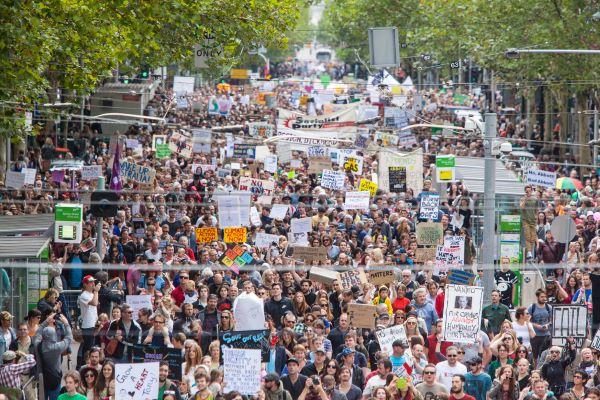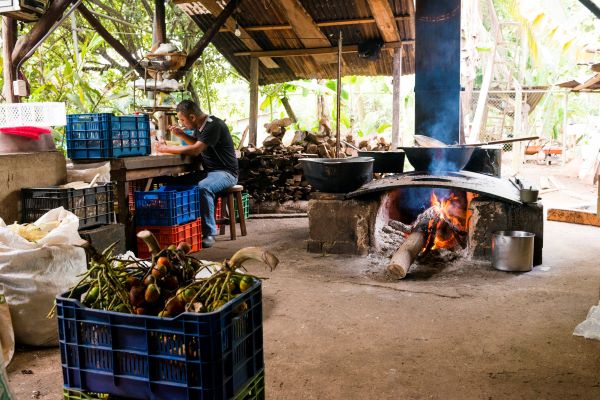It might appear opportunistic to link the climate and racial justice movements at a time when race is shaping the conversation in the media, in our workplaces, and in our homes. But as Dr. Ayana Elizabeth Johnson has recently explained, on the air and in her recent Washington Post op-ed, “Our racial inequality crisis is intertwined with our climate crisis. If we don’t work on both, we will succeed at neither.”
She’s right. These are deeply connected issues, so drawing these parallels can help expand the meaning of justice: because it is about race, about gender, about the climate, about food, about everything that matters.
What has become clear now is where all the overlap lies.
Social injustices, for instance, are driven by economies, politics, and institutions that generate prosperity for some and poverty and disenfranchisement for many. These systems of power and oppression are also evident in the way climate change impacts low-income countries hardest, as well as poorer individuals, minorities, and women anywhere in the world.
The ‘father of environmental justice,’ Dr. Robert Bullard, urges us to see all forms of justice as a single, deeply connected set of principles based on fairness and equity. “It’s all one book”, he said during a recent interview for the Climate 2020 podcast. Although he is deeply concerned about the present time, Dr. Bullard takes the long view and understands that the struggle carries on. “It’s a marathon,” he explains, best approached through a 30- or 50-year strategy, not a four-year plan, until the baton is passed to the next generation.
Related topics: Intra-Racial Conversations – Impact of a Murder – Take Climate Action To The Next Level
Unfortunately, when it comes to the climate, we don’t have this kind of time. The situation is only getting worse: as a result of human-caused climate change, by 2070 up to 3 billion people will need to move to escape temperatures too hot for humans to withstand and thrive in.
Righting these deep-rooted wrongs requires active, unrelenting support for movements that fight for justice in all its permutations. And if we are aiming to rewrite development pathways created by unfair systems, we must first break these systems down.
“I can’t breathe: Those words are incredibly important to the climate and environmental movement,” said Liv Havstad, executive director of Hip Hop Caucus, during an interview for the climate newsletter Heated. “How do we make sure this movement is responding to all the ways people can’t breathe, particularly black people?”
Indeed, the essential act of breathing has become a terrifying uncertainty for billions of us, as police brutality continues, unfairly funded healthcare systems break down, anxiety and depression rates soar, air pollution levels rise, and extreme heat becomes the norm.
Righting these deep-rooted wrongs requires active, unrelenting support for movements that fight for justice in all its permutations, racial justice included. It’s why, as Leah Thomas argues, every environmentalist should be anti-racist. And if we are aiming to rewrite development pathways created by unfair systems, we must first break these systems down.

Racial Justice By-passed: Instances of “Slow Violence” have been ignored for too long
Even though racism and the unequal impacts of climate change cause immeasurable damage every day, and have been doing so for a long time, this harm is often concealed from sight or ignored by those who don’t suffer them directly. The process is something akin to what Rob Nixon coined “slow violence“: “a violence that occurs gradually and out of sight, a violence of delayed destruction that is dispersed across time and space, an attritional violence that is typically not viewed as violence at all.”
Slow violences of injustice, racism, and inaction have crossed a threshold, becoming urgent and acute … existential questions we have long been asking ourselves are imbued with a renewed energy.
We are living in a historical moment, but not because anything new is happening: Tragically, pandemics have come and gone; people have suffered racial abuse and oppression for generations. And we have seen evidence of the climate and environmental emergency for decades now.
But the slow violence of injustice, racism, and inaction have crossed a threshold, becoming urgent and acute. Racial justice has been by-passed too many times. That makes this moment feel different. The existential questions we have long been asking ourselves are imbued with a renewed energy, which must be applied to confronting all forms of injustice.
It’s Broken, so let’s Fix it – Starting Now
Tackling injustice and achieving racial justice, however, means clashing head-on with systems that have been put into place and upheld by those in power.
Consider this: the creation of an institution and its raison d’être is shaped by the values of its creators—what they consider to be right and wrong. These values will ultimately determine the trajectory of the institution—for example, a nation that moves toward green growth or toward fossil fuels; a city that moves toward inclusive urban planning or toward neighborhood redlining.
The longer a society adheres to the values of its creators, the more woven into the fabric of day-to-day life they become, and the more difficult it can be to challenge the status quo.
One country that has managed to challenge dominant narratives and development models is Costa Rica. Andrea Meza Murillo, Director of the Climate Change Division in Costa Rica’s Ministry of Environment and Energy, explained during a recent interview with IISD that the government decided to maintain fuel prices at their higher, pre-pandemic levels and use the extra revenue to fund unemployment support schemes, which are now historically stretched.
Such a decision in the current global context reflects the nation’s sustained commitment to decarbonization and greener growth, while also reaffirming Costa Rica’s rejection of outdated models of development that put the economy before well-being.

But such inspiring examples as this one remain uncommon, as most institutions are self-serving and resist change.
In the wake of George Floyd’s death, the mayor of Minneapolis, Jacob Frey, admitted that reforming public institutions to address their embedded biases is almost impossible: “This is not just about the eight minutes of time where our officer had his knee on George Floyd’s neck,” he told the New York Times. “This is about the previous 400 years. This is about a hundred years’ worth of intentional segregation and institutionalized racism.” Though Mr. Frey was referring to racism in the local police force, the same discrimination exists in all kinds of systems.
The labelling of Indigenous Peoples as stewards of their ancestral lands, for example, has been used to limit their influence strictly to local issues and exclude them from bigger, nationally relevant conversations.
The narratives that institutions build for themselves will sometimes seek to disguise racist or post-colonial mentalities and pigeon-hole people in order to perpetuate carefully crafted status quos. The labeling of Indigenous Peoples as stewards of their ancestral lands, for example, has been used to limit their influence strictly to local issues and exclude them from bigger, nationally relevant conversations.
Even when in pursuit of noble causes, like ensuring the survival of humanity in the face of a climate emergency, the interests and competing priorities that come into play in constructing a narrative of resilience and progress will carry conflicting values and visions.
Is an Ambitious Climate Narrative Aligned with the Principles of Justice?
The narrative in climate discussions, widely supported by science, posits that a global temperature increase must be limited to 1.5°C above pre-industrial levels to avoid the catastrophic impacts of climate change. We fully support this ambition as the responsible and just thing to do; however, we need to match the enormous mitigation efforts needed to meet this target with massively scaled-up adaptation planning to prepare for a world in which the 1.5°C goal is not met, a world in which the lives and livelihoods of billions of people—especially those who are marginalized, living in poverty, and largely under-represented in global and national decision-making processes—are at risk.
This doesn’t mean we should give up on the 1.5°C target. On the contrary, the focus must be on a transformational approach to climate action that is more radical in reducing greenhouse gas emissions and, at the same time, sets mechanisms, funding, and actions in place to urgently address the needs of people in a world that is 2°C or 3°C warmer.
This may sound subtle but it would represent a huge departure from the existing climate narrative and bring justice closer to the center of climate action.
Let’s Start Acting for the Future We Want – One for the Planet and its People
We may soon look back to find that one of the great legacies of 2020 was planting a stronger sense of responsibility and activism in all of us to drive change—whether it manifests through protesting, changing our habits and values, or being more open to opinions we have previously shunned.
(…) This time
nothing, no one forgotten. We are here for the storm
that’s storming because what’s taken matters.
The words above, written by Claudia Rankine, eloquently point to the tragedies, injustices, and uprisings that are challenging us today, which will hopefully bring us closer together in the long run.
As the world spins out of orbit, we’re seeing the racial justice movement courageously laying the foundation for a new order—it’s our shared responsibility to help build it, but we must pick up the tools and get to work.
About the author: Daniel Morchain is a Policy Advisor with IISD’s Resilience Program, leading the National Adaptation Planning (NAP) processes in Colombia and Peru.
EDITOR’S NOTE: The opinions expressed here by Impakter.com columnists are their own, not those of Impakter.com.















